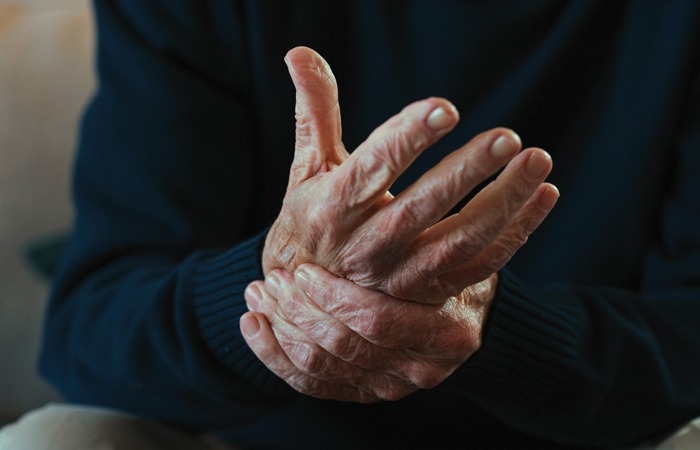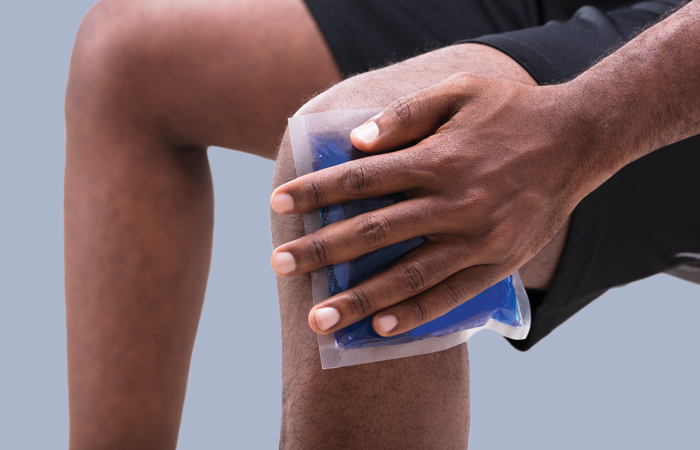In OTC
Follow this topic
Bookmark
Record learning outcomes
Everyone experiences pain at some point in their life – falling off of a bike as a child, experiencing emotional pain as a teenager, suffering from a migraine as an adult. These are all experiences of pain, but each will feel distinctive, lasting for differing amounts of time, with specific causes and treatments. In the pharmacy, you may deal with any or all of these types of pain in a single day. Often, however, we give each of these occurrences the general term of ‘pain’, when really, we could be much more specific. You will probably have heard of acute and chronic pain, but lesser known is peripheral neuropathy, despite it affecting an estimated one in 10 people aged 55 and over in the UK.
What is peripheral neuropathy?
Peripheral neuropathy occurs when the network of nerves on the periphery, outside of the central nervous system – the brain and spinal cord – are damaged. This includes sensory nerves, responsible for carrying messages of sensations like pain and touch to the brain; motor nerves which control muscles and movement; and automatic nerves which control involuntary functions of the body, such as blood pressure and bladder function.
Damage to these nerves leads to neuropathic pain. “It might be that your nerves are damaged or are malfunctioning – think of it as though your nerves are misfiring – so while someone might be experiencing a burning, tingling, shooting, or stinging pain, there is no obvious source,” explains research from Voltarol. An example of neuropathic pain is shingles – which can affect the nervous system by causing nerve inflammation and damage.

Peripheral neuropathy mainly affects the body’s extremities, so cramping in the hand(s) is a common symptom.
Spotting the symptoms
Nerve damage can be caused by physical trauma, exposure to toxins or chemicals, or certain medical conditions like cancer, diabetes and autoimmune disorders. The symptoms will differ depending on which type of nerve has been damaged and thus what form of peripheral neuropathy presents. Here is a breakdown of the most common forms:
Sensory neuropathy
Sensory neuropathy symptoms include pins and needles in the affected body part; numbness and less ability to feel pain or changes in temperature (particularly in the feet); a burning or sharp pain (usually in the feet); feeling pain from something that should not be painful, like a very light touch; and loss of balance or co-ordination caused by a weakened ability to tell the position of the feet or hands. For example, people with diabetes who lose feeling in their feet are suffering from sensory neuropathy.
Motor neuropathy
Damaged motor nerves can lead to twitching or muscle cramps; muscle weakness or paralysis affecting one or more muscles; wasting of muscles; and difficulty lifting up the front part of the foot and toes, particularly when walking.
Autonomic neuropathy
If the automatic nerves have been affected, customers may experience constipation or diarrhoea, especially at night; feeling sick, bloating and belching; low blood pressure causing them to feel faint or dizzy when standing up; rapid heartbeat; excessive sweating or lack of sweating; problems with sexual function, for example, erectile dysfunction; loss of bowel control; and difficulty urinating.
What causes it?
Due to the different variations, peripheral neuropathy symptoms can be caused by a variety of health conditions – with type 1 diabetes and type 2 diabetes being its most common cause. This is due to high levels of sugar in the blood, damaging tiny blood vessels that supply the nerves. Other conditions which can lead to peripheral neuropathy include:
- Excessive alcohol drinking over many years
- Low vitamin B12 levels
- Physical damage to the nerves through injury or surgery
- An underactive thyroid gland
- Certain medicines, including antibiotics; metronidazole and nitrofurantoin
- Infections like shingles, Lyme disease and HIV.
Red flags
Many of the symptoms of peripheral neuropathy should not be ignored, especially if it is the first time someone is experiencing it – or if they are diabetic. The symptoms may indicate that the person is prediabetic, or that someone with diabetes is experiencing potentially irreversible blood sugar problems. Customers should visit their GP if they experience:
- Pain, tingling or loss of sensation in the feet
- Loss of balance or weakness
- A cut or ulcer on the foot which isn’t getting better.
The sooner peripheral neuropathy is diagnosed, the sooner further complications can be prevented and nerve damage limited.
“No one should have to live with monthly episodes of disruptive pain when effective treatments exist”
Menstrual pain
Most women will experience some form of menstrual pain – also referred to as period pain or dysmenorrhea – during menstruation, but each person’s experience is unique. Katy Vincent, member of the British Pain Society and professor of gynaecological pain and honorary consultant gynaecologist, sheds some light on this condition which affects about half of the population. “We don’t yet fully understand what causes pain with menstruation, but it is likely that it is a combination of factors that vary between individuals,” says Katy.
Period pain occurs when the womb tightens during the period, and is a normal part of the menstrual cycle. “Menstruation is also associated with uterine contractions [muscle contractions in the uterus],” says Katy, which can cause mild to extreme pain.
“There is huge variation in menstrual pain. For some it will start with the onset of bleeding and last for one to two days. However, for others it may start a number of days before bleeding starts and persist throughout or even beyond the end of the period,” says Katy. Pain is described as cramps in the lower abdomen and pelvis, often also including the lower back and down the legs. “One of the problems with painful periods is that we don’t really know what ‘normal’ is and menstruation is still not discussed as openly as it could be, thus many people don’t realise that their symptoms are bad enough to seek help for,” says Katy.
What can help?
“NSAIDs are the initial treatment for dysmenorrhoea and the majority (80 per cent) will get some benefit from these,” says Katy. “We would recommend starting to take them just before the period is due and using them regularly until the pain settles rather than waiting for them to become unbearable.” Katy also recommends using “local heat, either a hot water bottle, wheat bag or stick-on patch” or a transcutaneous electrical nerve stimulation (TENS) machine to combat pain. This works by using a mild electrical current to encourage blood flow to the area.
“Gentle exercise is described as helpful by many, and this is a situation where we would recommend people listen to their bodies to see if it is helpful for them,” says Katy. “If self care or over-the-counter strategies are ineffective, we would encourage people to seek further help no matter what their age, as no one should have to live with monthly episodes of disruptive pain when effective treatments exist.”

Using heat therapy like hot water bottles can help to ease menstrual cramps.
Red flags
As period pain can also be caused by underlying issues like endometriosis or adenomyosis, customers who are experiencing unbearable or consistent pain should visit their GP. Other red flags to look out for include bleeding during periods; pain during sex; severe pain that significantly impacts daily activities like going to work or school; new or sudden onset of intense pain; pain that doesn’t improve with medication, foul-smelling vaginal discharge; and pain accompanied by fever.
“Unfortunately, there is also still a message that menstrual pain is something that girls and women should learn to put up with and many worry that their pain will be dismissed or not taken seriously if they do ask for help,” says Katy. Pharmacy teams, therefore, play a crucial part in eradicating this narrative around menstrual pains. By listening attentively to customers and providing them with options to treat their period pains, pharmacy teams can dispel the notion that dysmenorrhea should be dealt with quietly.
Turning to treatments
Most treatment should be aimed at treating the underlying cause. For example, pharmacy teams can advise diabetic customers to implement lifestyle changes like stopping smoking, cutting down on alcohol and exercising regularly. Those with a vitamin B12 deficiency can be recommended B12 tablets or injections, and those who may be suffering from neuropathic pain as a side effect from medication should discuss possible alternatives with a GP. Other recommendations include acupuncture, and physiotherapy to help weakened muscles.
Customers facing continuous pain may need to visit a GP for further testing.
For pain that does not need to be referred to the pharmacist or GP, there are various options the pharmacy team can recommend. Most of the time, a painkiller like paracetamol or ibuprofen is sought out by customers. While they are both widely used to relieve pain, they have different properties for specific symptoms, are broken down by the body differently, and have different drug interactions.
When to use paracetamol
Paracetamol can be taken to reduce pain caused by toothaches, headaches, stomach-aches, and joint and muscle pain, including mild arthritis pain. It does not need to be taken after food, and can usually be taken with other medicines. However, customers should always check if their other medication contains paracetamol as adults should not exceed more than eight 500mg tablets in 24 hours.
When to use NSAIDs
Like paracetamol, non-steroidal anti-inflammatory drugs (NSAIDs) like ibuprofen are used to relieve pain, but they also work to reduce inflammation and bring down a high temperature. They can be recommended to ease pain caused by headaches, painful periods, sprains and strains, colds and flu and conditions like arthritis.
Customers should speak to a pharmacist or GP before taking a NSAID if they:
- Are asthmatic
- Have had stomach ulcers in the past
- Are breastfeeding, pregnant or trying for a baby
- Aged under 16 or over 65
- Have had an allergic reaction to NSAIDs in the past
- Have any heart, kidney, liver, blood pressure, circulation or bowel issues.
Customers should contact 111 if they take too much paracetamol or ibuprofen, even if they feel well.
“Cold therapy, which is part of PRICE, is scientifically proven to reduce blood flow to a particular area”
Hot versus cold
Using hot and/or cold treatment to relieve pain is an excellent option for customers, and is especially useful for those who prefer a pill-free solution. However, applying heat or cold therapy to an area provides different responses, and each should only be used with this in mind.
“For those customers who sustain a minor injury, they need cold therapy in the initial 42-72 hours,” says senior brand manager for Deep Heat and Deep Freeze, Elaine Walker. Adhering to the protect, rest, ice, compress and elevate method. This could be when someone sprains an ankle, or slams their thumb in a car door. “Cold therapy, which is part of PRICE, is scientifically proven to reduce blood flow to a particular area, which can help reduce swelling and soothe muscle and joint health angst.”
Mark Burdon, pharmacist and adviser to Deep Heat and Deep Freeze, advises that “using cold therapy immediately after the injury will help to limit the body’s response to the injury, reducing bleeding to the tissues, preventing or reducing swelling and inflammation and reducing pain”.
“Once swelling and inflammation have subsided – usually around 72 hours – using warming products can help increase blood flow and help promote healing,” says Elaine. By increasing blood supply to the affected area, heat therapy “[reoxygenates] the tissues, to help stimulate the natural healing process” adds Mark. Heat therapy relaxes aching and over-tired muscles, which can be especially useful for anyone feeling stiff.
Pain relieving medication that uses capsaicin extract – an active component of chilli peppers with analgesic properties – found in heat patches and creams works by stopping the nerves from sending pain messages to the brain.
Mark recommends that applying heat to an area can be done:
- Every day: to ease and release knots
- Before exercise: to loosen and soften muscles, so they can move more easily
- To rehabilitate soft tissue: to help realign muscle fibres and break down adhesion and scar tissue.

Cooling therapy works to reduce the inflammation and swelling to an area.

